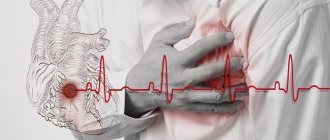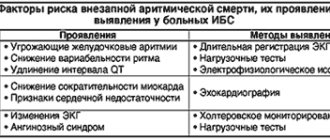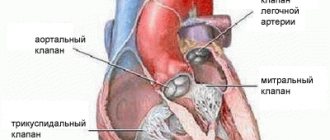Medical services
Federal State Budgetary Institution "NMITs SSH im. A.N. Bakulev" of the Russian Ministry of Health provides specialized medical care in the following profiles:
- cardiovascular surgery
- pediatrics
- transplantation
The Center for Cardiovascular Surgery works with insurance companies accredited in the compulsory medical insurance system. Compulsory medical insurance programs can provide assistance to patients with diseases of the veins of the lower extremities, unstable angina and heart rhythm disturbances.
Treatment at the Bakulevsky Center is effective, which is due to the highly qualified staff and the use of medicines and medical products of the latest generation.
At the National Medical Research Center of Sports Sciences named after. A.N. Bakulev" provides the following medical services:
- Specialist consultations
- Telemedicine consultations
- Diagnostics
- Surgery
Heart surgery
Congenital heart defects
In the center named after A.N. Bakulev’s clinic treats all described types of congenital heart defects, including particularly complex and unique cases.
- Patent ductus arteriosus
- Coarctation of the aorta
- Atrial/ventricular septal defects
- Pulmonary atresia
- Transposition of the great arteries
- Origin of the great arteries from the right ventricle
- Congenital heart valve abnormalities
- Other
Cardiac surgeries are performed both under artificial circulation (CPB) and without CPB. Surgical treatment of congenital heart defects in children, including newborns and children under one year of age, is possible.
Acquired heart defects
At the National Medical Research Center for Cardiovascular Surgery, operations are performed for acquired heart disease (heart valve replacement), including on multiple valves and for complicated single-valve defects under cardiopulmonary bypass conditions.
Bakulevka specialists perform operations for acquired heart defects with on-pump, operations on multiple valves and complicated single-valve defects with on-pump, plastic surgery in combination with CABG (MCB), as well as particularly complex and unique operations for PPS under artificial circulation.
Heart rhythm disturbances
The Bakulev Center has several departments that treat cardiac arrhythmias. The following are performed: all possible procedures related to pacemaker (implantation, reimplantation, removal, replacement), with electrodes (removal, position correction), radiofrequency ablation , electrophysiological study (for AF, VT, SVT, AT, WPW), removal of atrial fibrillation . In particular, at the National Medical Research Center for Cardiovascular Surgery, complex and unique operations with artificial circulation are performed to treat arrhythmias.
Coronary surgery
At the “Center named after A.N. Bakulev" performs operations using a closed technique, uncomplicated operations on the coronary arteries with IR (including single bypass), operations without IR (including laser tunneling), operations with artificial circulation, multiple CABG and MCB in combination with cardiac aneurysm, repeated CABG and MCB with multiple lesions of the peripheral arteries (including with the use of laser).
Surgical treatment of cardiomyopathies
The Department of Surgical Treatment of Cardiomyopathies of the National Medical Research Center for Cardiomyopathy diagnoses and treats various forms of cardiomyopathies. Operations performed:
- Surgical interventions using a closed technique
- Closed operations
- Complex and particularly complex operations with IR (including using laser)
- 24-hour monitoring of pulmonary artery pressure
Vascular surgery and angiology
The Institute of Coronary and Vascular Surgery (as part of the A.N. Bakulev National Medical Research Center for Cardiovascular Surgery) has a number of specialized departments whose specialists successfully treat diseases and pathological conditions of the great vessels.
Procedures performed:
- Operation Crossectomy
- Operations on the veins of the lower extremities and lymphatic vessels, lymphovenous occlusion, phlebectomy
- Non-reconstructive vascular surgery
- Reconstructive operations on peripheral vessels, femoral-tibial bypass surgery
- Coarctation of the aorta without IR
- Extravasal compression of subclavian and vertebral arteries and veins
- Operations with IR and others
Department of Gravity Blood Surgery and Endoscopy
- Bicarbonate hemodialysis, artificial kidney
- On-line hemofiltration
- Discrete plasmapheresis
- Treatment of hypercholesterolemia using extracorporeal blood purification (HELP therapy)
- Cascade lipaferesis and other procedures
X-ray surgical methods for studying and treating the heart and blood vessels
At the National Medical Research Center for Cardiovascular Surgery, X-ray surgical research and treatment methods are used for the treatment and pathology of the heart and blood vessels, such as:
- Coronary angiography
- Ventriculography
- Vascular angiography
- Coronary angiography in combination with ECHO, OCT, etc.
- Balloon angioplasty
- Embolization coil
- Transcatheter closure of ventricular and atrial septal defects
- Stenting of arteries (including carotid) and many other procedures
Types of operations
The hospital performs the following operations on the main organ:
- Closed. The heart itself remains intact. All actions are performed outside the organ. Its cavities are closed.
- Open. The organ cavities open up. The activity of the heart and lungs stops for a while.
- X-ray surgery. Special equipment is used. The manipulation is performed under computer control.
Operations that treat the heart are classified as follows (the type depends on the patient’s condition and the type of pathology):
- Emergency. The manipulation must be carried out immediately (after an accurate diagnosis has been made). Otherwise the patient will die.
- Urgent. Preparation for them takes several days, but no more. Otherwise, the patient will have complications or die.
- Planned. They are prescribed only after the consent of the operated patient. They can be produced at any time.
Classification of operations by approach:
- radical (completely cure the pathology);
- palliative (improves the condition or is a preparation before radical intervention).
The most common types of operations:
- stenting of the coronary arteries of the heart;
- heart valve replacement;
- vascular bypass;
- radiofrequency ablation;
- Glenn and Ross method;
- heart transplant.
Each type of surgical intervention has contraindications. Therefore, the method of influence is selected personally for each person.
Equipment for carrying out
No specialized equipment is required for closed surgery. Only ordinary surgical instruments. During a closed operation, a device for artificial circulation of blood fluid is required, since the heartbeat and lung function are temporarily suspended.
The X-ray surgical method uses specialized catheters and equipment that is attached to them. They are introduced into the organ cavity or into the intravascular lumen to eliminate pathology. The operation is monitored on a computer monitor.
What determines the cost of coronary bypass surgery?
The operation, although relatively common, is far from simple. There are a huge number of factors that influence the invoice that will be issued.
- Technology - if a mini-access is used, then the cost of the operation itself increases significantly, but the rehabilitation period will be much shorter, because in this technology there is no dissection of the chest.
- Difficulty - before any surgical intervention, and indeed before making a diagnosis, it is customary to conduct an examination to understand how advanced everything is, how potentially complex the operation will be, whether there are great risks, whether there is a need for such a serious intervention at all. And the worse the situation, the more expensive the operation will cost.
- The patient’s status is in Russia; if the patient is a foreigner, then in most cases coronary bypass surgery will cost him one and a half times more. Discounts are usually provided for healthcare employees.
- Qualification of the surgeon - the higher the category of the operating doctor, the more expensive his services will cost.
If you suddenly need such a procedure, you need to be prepared to pay twice or three times the originally stated price.
Heart bypass surgery in German clinics: examination plan
The study of the functional state of the myocardium consists of the following procedures:
- examination by a cardiac surgeon (drawing up treatment tactics, explaining the essence of the operation);
- electrocardiographic (ECG) recording of heart condition;
- determination of heart function under load conditions (ECG recording after bicycle ergometry);
- daily monitoring of myocardial function (Holter monitoring);
- Ultrasound of the heart;
- Doppler examination of peripheral vessels;
- 24-hour blood pressure monitoring.
Then coronary angiography is performed, which determines the condition of each vessel of the heart muscle. In German clinics, coronary angiography is most often performed with simultaneous vascular bypass surgery. In Russia, these manipulations are carried out sequentially, which requires repeated surgical intervention on the body.
Coronary angiography is performed by inserting a plastic tube with a camera into the damaged vessel. The level of patency of the coronary artery is visually determined on the monitor. The procedure can be performed with simultaneous medical manipulations. Detection of ischemic myocardial disease is an indication for heart bypass surgery.
When is valve replacement required?
The heart is responsible for delivering blood and oxygen to all tissues of the body. Any disturbances in the functioning of the organ inevitably have a negative effect on the body and require treatment. Often the problem can be solved conservatively, that is, without resorting to invasive intervention. But this does not always happen, and in some cases surgical replacement of the aortic valve cannot be avoided. The main problems of the aortic valve include:
- Congenital and acquired defects. This category includes any changes that interfere with normal blood flow and increase the workload of the heart.
- Valve stenosis, in which the ejection of blood into the aorta is impeded.
- Rheumatic diseases, streptococcal infection.
- Aneurysm, aortic dissection.
- Change in shape, valve damage, calcification, sagging valves.
- The valve does not close tightly, blood flows in the opposite direction.
- Inflammation.
Make an appointment with a specialist without queues, at a convenient time
Sign up
+7
When the pathology is at an early stage of development, it can often be eliminated without surgery. In serious cases, when medications cannot solve the problem, surgery is used. An artificial valve made in the laboratory, as well as an element of the patient’s own tissues, can be installed. The second option is cheaper, since you do not need to purchase an expensive prosthesis.
Research and specialist consultations required to perform cardiac surgery
Coronary artery bypass grafting
- Coronary angiography, ventriculography (if necessary)
- Transthoracic echocardiography
- Treadmill test
- ECG
- Laboratory research methods
- X-ray of the chest organs
- External respiration function
- Doppler examination of brachiocephalic vessels
Heart valve surgery
- Transthoracic echocardiography
- Transesophageal echocardiography
- Coronary angiography
- ECG
- Laboratory research methods
- X-ray of the chest organs
- External respiration function
- Doppler examination of brachiocephalic vessels
- Consultation with an ENT doctor
- Dentist consultation
In complicated cases, other examinations may be needed, for example, radionuclide scintigraphy of the myocardium, computed tomography of the brain, computed tomography of the lungs, nuclear magnetic resonance, etc.
Advantages of coronary surgery in Germany
Surgical intervention for ischemia in German clinics is performed using a minimally invasive method on a beating heart without the use of artificial circulation. Access is made through the anterolateral surface of the chest wall. An incision up to 10 cm long is made in the third or fourth intercostal space, then coronary artery bypass grafting is performed.
The surgical technique without disconnecting the heart from the circulatory system involves separating a section of the thoracic artery. Then a section of the vessel for implantation is cut off and the cut ends are sutured. After this, they proceed to the application of anastomoses. Benefits of heart bypass surgery:
- absence of risks that occur when using artificial blood circulation;
- minimal damage to the heart muscle;
- small volumes of blood transfused;
- short treatment and recovery period;
- absence of cerebral vascular complications and infection of the postoperative wound.
Coronary artery bypass surgery, performed in German cardiology clinics, allows the patient to begin work and active life within 7-10 days. The development of cardiac surgery in Germany gives seriously ill patients a chance of recovery. After many years of suffering from attacks of angina and shortness of breath with minor exertion, patients are relieved of pain the day after bypass surgery.
Examples of prices for cardiac bypass surgery
For a foreigner who needs to undergo surgery with plastic surgery of 3 valves in Moscow from one of the best specialists, it will cost about a million rubles, excluding rehabilitation costs. For a healthcare worker in Russia, the same procedure will cost about 700,000 , also excluding rehabilitation. Coronary artery bypass surgery on a living beating heart (without artificial blood flow) for Russian citizens will cost about 200,000 rubles , for foreigners approximately 350,000 .
Indications for surgical treatment of coronary vessels
Coronary artery bypass surgery - the formation of bypass blood flow in stenotic vessels - is performed according to specific indications:
- narrowing of the left coronary artery by more than 50%;
- resistance to therapeutic methods for treating angina pectoris;
- violation of myocardial contraction;
- extensive area of ischemia;
- atherosclerotic damage to several vessels;
- arterial damage in patients with concomitant pathologies;
- narrowing of coronary vessels more than 70%.



